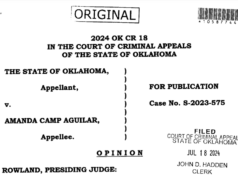
(Update: This story was updated at 12:24 p.m. Tuesday, Oct. 10, to reflect that the city has tabled discussion of the proposed overlay districts indefinitely. Prior to the proposal being tabled, this article was previously updated to include a link to more recent ordinance language that was created following the Central Edmond Urban District Board meeting on Tuesday, Sept. 12. The article below remains in its original form.)
Newly proposed overlay districts for downtown Edmond could streamline the process by which property owners can construct new residential buildings, but some residents have said eliminating the public hearing process in front of the Planning Commission and City Council would be a mistake.
If approved later this fall, the three proposed Edmond urban residential overlay districts would allow included property owners to add accessory dwelling units, live-work spaces, duplexes, triplexes and quadplexes to their properties without site plan approval.
In order for a property owner to build one of those structures, the underlying zoning on the property would still need to allow each respective use. For homeowner associations that disallow multifamily dwellings, those rules would still apply to building duplexes, triplexes or quadplexes. However, HOA’s could not prevent a property owner from constructing an accessory dwelling unit or a live-work unit on a property within the proposed EURO boundaries, according to the proposed ordinance.
Pictured above and outlined in red, the proposed overlay districts — which would cover half of a square mile in the city — would streamline the planning process in these areas. The boundaries are proposed for areas in which many of these structures already exist, said David Chapman, a developer and a former Ward 1 Edmond city councilman.
“It sometimes takes three months to get something on the docket, and that just kills you as a developer,” Chapman said. “And everybody knows it’s going to be approved anyway, right?”
Those opposing the overlay district believe bypassing the public hearing process for these builds could hurt neighbors’ quality of life.
“You’ve got a resident sitting here in a single family home — they get no notice, they get no opportunity to have any input before something like this comes in next door to them,” said Lydia Lee, vice president of the Edmond Neighborhood Alliance. “That’s kind of concerning to me.”
The proposed overlay district is scheduled to be discussed and considered by the Central Edmond Urban District Board at 5:30 p.m. in the City Council chambers. The item is also scheduled to be discussed before the Edmond Planning Commission on Sept. 19. Ultimately, the Edmond City Council would need to vote on approving the overlay district proposal.
Tom Robins, Ward 1 Edmond City Councilman, said he wants to hear citizen input on the proposed districts before casting his vote.
“The 0.5 square mile area being considered is right next to UCO and the neighborhood near the Barnett splash pad. The proposed area has a wide variety of housing options that meet multiple stages of life, and I want to ensure it continues to do so,” Robins said. “Before I vote, I’m interested in hearing from citizens who have any unanswered questions about what the city is proposing. I also invite neighbors to make public comment at the upcoming meetings and City Council meeting when it’s on the agenda.”
Follow NonDoc’s Edmond coverage
‘Options for a unique area’
Chapman and Josh Moore, both developers whose Edmond City Council terms expired in May, discussed implementing overlay districts around downtown during their elected tenures in the hope of spurring more housing options at a faster rate.
With three districts now proposed near the University of Central Oklahoma and the downtown area, Moore said he hopes approval could provide young Edmondites with more housing options before and after they graduate.
“Not that there haven’t been challenges before, but we are truly in a period right now of — where do a large portion of your workforce in your community — where do they live?” Moore said. “Your young people that either don’t want to leave Edmond or want to move back to Edmond to be closer to family, or their job, we need to be cultivating our workforce and our business leaders for tomorrow. We want them to live in our community.”
Chapman said the overlay districts would naturally add more affordable housing, particularly in regards to the construction of accessory dwelling units.
“I think this is a way that we can satisfy the needs for a bit of affordable housing and density without the multifamily that the communities tend to resist,” Chapman said.
Lee said the Edmond Neighborhood Alliance has not yet discussed the proposed overlay district at a board meeting, but she said she is concerned about the setbacks for live-work units and accessory dwelling units. In the proposed ordinance, the setbacks for live-work units are listed at 10 feet for front and backyards, 15 feet for backyards abutting existing residential uses, and zero feet for side yard setbacks. Setbacks for accessory dwelling units can be set as low as five feet in the back yard and three feet in the side yard.
“These buildings can go all the way to the property line,” Lee said. “There’s a provision — and they say it in the ordinance — the HOA’s cannot limit these type of units. If you’ve got a neighborhood association with restrictive covenants and guidelines, they’re just saying those don’t apply.”
For accessory dwelling units, one provision listed in the proposed ordinance notes that, “If the ADU is two-stories, proximity to neighboring residences with privacy concerns may need to be addressed.”
“May is not shall,” Lee said. “And how are those addressed? If there’s no notice and no public hearing, how do you address those privacy concerns?”
On the location of the districts, Moore said several accessory dwelling units, live-work spaces and duplexes already exist within the proposed districts.
“We know it’s appropriate. It’s been deemed appropriate,” Moore said. “Let’s just speed up the timeline for when it can basically get built or get to market and be available.”
Chapman said properties within overlay districts tend to see more development once the districts are implemented.
“It’s more attractive for people to make changes, and that tends to make people active in building in those areas,” Chapman said. “So, they tend to do it in areas that could use development help.”
If the overlay districts are ultimately implemented in Edmond, Lee said she fears developers will tear down affordable homes in favor of new development.
“I guarantee investors and developers are going to come in, and if they can buy a little frame house on a pretty decent size lot for $88,000, they’re gonna do it, tear it down and build these things,” Lee said. “So, I think that is the ultimate outcome.”
Moore noted that the proposed overlay districts, if approved, would not require property owners to make changes to their properties, nor would implementation of the overlay districts automatically rezone their property.
“If somebody wants to keep a single-family home with a deep backyard in that area, they are perfectly allowed to keep it that way,” Moore said. “What this does is just opens up options for a unique area and unique district that’s changing over time.”





















